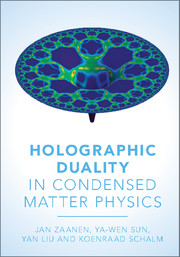Book contents
- Frontmatter
- Contents
- Preface
- 1 Introduction
- 2 Condensed matter: the charted territory
- 3 Condensed matter: the challenges
- 4 Large-N field theories for holography and condensed matter
- 5 The AdS/CFT correspondence as computational device: the dictionary
- 6 Finite-temperature magic: black holes and holographic thermodynamics
- 7 Holographic hydrodynamics
- 8 Finite density: the Reissner–Nordström black hole and strange metals
- 9 Holographic photoemission and the RN metal: the fermions as probes
- 10 Holographic superconductivity
- 11 Holographic Fermi liquids: the stable Fermi liquid and the electron star as holographic dual
- 12 Breaking translational invariance
- 13 AdS/CMT from the top down
- 14 Outlook: holography and quantum matter
- References
- Index
3 - Condensed matter: the challenges
Published online by Cambridge University Press: 05 November 2015
- Frontmatter
- Contents
- Preface
- 1 Introduction
- 2 Condensed matter: the charted territory
- 3 Condensed matter: the challenges
- 4 Large-N field theories for holography and condensed matter
- 5 The AdS/CFT correspondence as computational device: the dictionary
- 6 Finite-temperature magic: black holes and holographic thermodynamics
- 7 Holographic hydrodynamics
- 8 Finite density: the Reissner–Nordström black hole and strange metals
- 9 Holographic photoemission and the RN metal: the fermions as probes
- 10 Holographic superconductivity
- 11 Holographic Fermi liquids: the stable Fermi liquid and the electron star as holographic dual
- 12 Breaking translational invariance
- 13 AdS/CMT from the top down
- 14 Outlook: holography and quantum matter
- References
- Index
Summary
If this book ever makes it to a second edition, this is most likely to be the chapter that will have to be most thoroughly rewritten. Is there a need in condensed matter physics for a theory that goes beyond the paradigm which we sketched in rough outline in the previous chapter? If so, would the lessons of AdS/CMT which are found in the later chapters be of any relevance for this purpose?
At present the fog of war is still obscuring the battlefield. This war started some thirty years ago with the discovery of high-Tc superconductivity. Before this event, there was a sense that insofar as metals and superconductors are involved the fundamentals could be understood in terms of the “fifties paradigm” of the previous chapter. In the frenzy that followed the high-Tc discovery, experiments showed that strange things were happening. The reaction of the mainstream was to try to tamper with the established paradigm, to accommodate the anomalies. However, Philip W. Anderson, who was very influential back then, took the lead in insisting that new physics is at work in the copper oxide electron systems [86]. This in turn had a great impact on the research agenda. During the subsequent thirty years the field diversified to other materials, while the repertoire of experimental methods employed to study the electrons in solids greatly expanded. Literally millions of papers were written on the subject. But some of the most basic questions formulated in the late 1980s are still awaiting a definitive answer. It is just impossible to do justice to this large and confusing literature in the present context (see e.g. [87]). We will therefore present here a small selection of subjects, which is intended to form a minimal background for the holographist to communicate with the condensed matter community.
Back in the late 1980s the great puzzle was why the superconducting transition temperature could be as high as 150 K, given that the conventional phonon mechanism runs out of steam at 40 K or so. It was also realised early on that the electron systems in cuprates are characterised by unusually strong inter-electron repulsions. An aspect that is well understood in these systems is the microscopic physics.
- Type
- Chapter
- Information
- Holographic Duality in Condensed Matter Physics , pp. 73 - 104Publisher: Cambridge University PressPrint publication year: 2015



